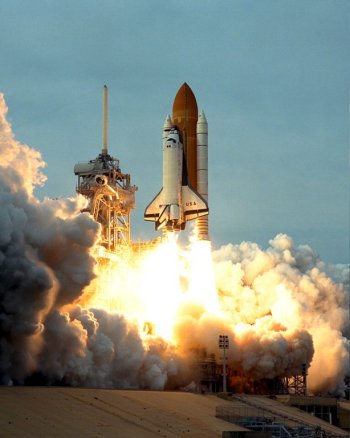Rocket Boys
Today, a book with a surprising subtext. The University of Houston's College of Engineering presents this series about the machines that make our civilization run, and the people whose ingenuity created them.
"Not another boys' coming-of-age story," a friend says when I recommend Homer Hickam's book, Rocket Boys. But Rocket Boys does something remarkable with that genre. It's been made into the movie October Sky (that's also the paperback title). I haven't seen the movie and may not bother. It could hardly improve on the book.
Homer Hickam was fourteen in Coaltown, West Virginia, when the Russians launched Sputnik. The steel companies were losing interest in Coaltown's deep mining operation. The imminent death of the mine was obvious to everyone but Homer's father -- one of the mine's senior managers. Young Homer senses the decay of his world on a visceral level. What he does see very clearly is that he wants to build rockets. He wants to go to work for Werner von Braun.
Football is king in Coalville -- no sympathy for foreign rocketry. Homer looks for a book on rocket-making. Of course, there is none. He eventually recruits three friends, and they set out to invent their own rocket. Now play for a moment with that problem. I mean building a real rocket that'll travel miles straight up!
You need a chemical propellant and a binding agent for the fuel. You need to shape the fuel within the rocket. You need metals to withstand the temperature of burning fuel. The shape of the necessary supersonic nozzle is not only mathematically complex; it's also a completely unexpected form. A true guidance system would be far too complex. Without one, you need accurate tail fins and a launch system to aim it properly. You need means for measuring the height of the flight.
All these things the four boys accomplished. They did it against a backdrop of economic and domestic chaos -- and in a world that couldn't comprehend their work. I don't think I'm letting cats out of the bag to say they eventually hurled a rocket six miles into the sky and won a national science fair prize as well.
On the surface, the book leads us through their problem-solving process. But the problems of the rocket fuse with the problems of Coaltown and troubled family lives. As the tale unfolds, we're hardly aware that we're learning college-level thermodynamics, fluid mechanics, chemistry, dynamics, and metallurgy. That's because each of those issues mirrors into one or another of the crushing problems that go with hacking a living out of a dying company town. It is a remarkable piece of multilevel story-telling.
Homer Hickam went on to become an engineer. He never met von Braun, but in the 1980s he joined NASA. He did meet the Russian engineers who launched Sputnik. And, in 1997, an astronaut carried one of his old rocket nozzles on the shuttle Columbia. Only ghosts of his childhood linger in the remnants of Coaltown. But they're benign ghosts. They are that array of surmountable trials we must all undergo if our lives are to find any form or contentment.
I'm John Lienhard, at the University of Houston, where we're interested in the way inventive minds work.
(Theme music)
Hickam, H. H., Jr., October Sky (aka Rocket Boys). New York: Island Books, 1999.
Toor, M., Rocket Boys. West Virginia, March 1999, pp. 24-25. (This book review includes photos of Homer Hickam and his rockets.)
Hickam, H. H., Jr., On Writing Rocket Boys, October Sky. West Virginia, June 1999, pp. 34-36. (I am grateful to Mary R. Chaffey of Elkins, WV and Pat Bozeman, UH Library, for providing both West Virginia articles.)
As a footnote to this story, I recently learned that Dr. Alan (Russ) Geanangel, UH Chemistry Dept. did much the same thing as Homer Hickam did, and at about the same time, in Cadiz, Ohio. (Cadiz is little more than a hundred miles from Coaltown.) He and fellow student John O'Neil developed a rocket, with encouragement from their chemistry teacher, Lucy Patterson. Their rocket achieved an altitude just under one mile. That was less than the Rocket Boys managed, but they built a more sophisticated two-stage device. (Bullard, J. B., Two Cadiz High School Students Plan to Fire Multi-Stage Rocket, Martin's Ferry Paper, ca. 1958.)

Launch of Shuttle Columbia, flight STS-87
Japanese astronaut, Dr. Takao Doi, is, at long
last carrying Hickam's science fair medal and
a piece of one of his rocket nozzles into space.
(Image courtesy of NASA)